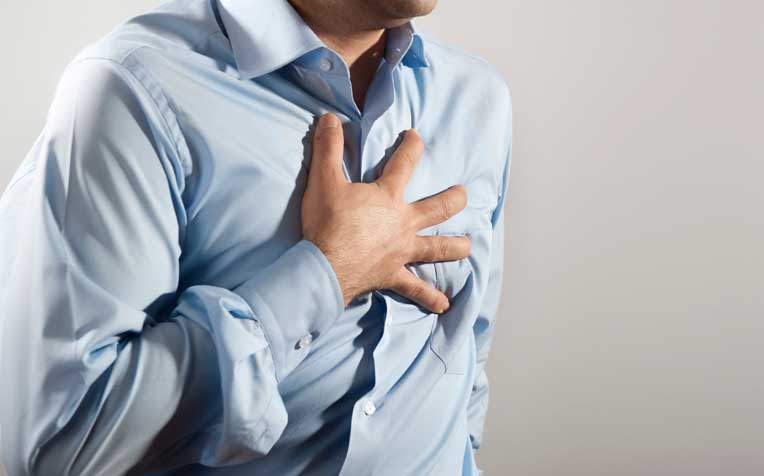
Heart attack symptoms include severe chest pain, breathlessness, sweating or nausea.
Severe chest pain and a combination of the following symptoms can mean a person is having an acute heart attack (known medically as a myocardial infarction), shared Professor Marcus Ong, Senior Consultant, Department of Emergency Medicine, Singapore General Hospital (SGH), a member of the SingHealth group.
The severe chest pain experienced when a heart attack strikes is often likened to something very heavy pressing on the chest, and described as the worst pain suffered in a person's life.
Dos and don'ts during a heart attack (myocardial infarction)
 Dos
Dos
Call 995 for an ambulance.
Paramedics are trained to stabilise the patient’s condition with medication, and the ambulance is equipped with a defibrillator to resuscitate the patient should the heart stop en route.
Give clear instructions to the paramedics on finding the patient’s home, have someone wait at a visible location to guide the paramedics and hold the lift open if the patient lives in a high-rise building, so as to save time.
Get ready the patient’s personal effects such as personal identification, medical benefit identification, insurance and other documents for admission.
Have the patient seated in a location where he can be transferred easily to a stretcher.
Give a clear account of what happened.
Let the paramedics know about any drug allergies or past medical history
 Don’ts
Don’ts
Drive or take public transport to the hospital, even if the patient lives nearby. As the patient’s condition may deteriorate en route, it is safer to wait for an ambulance. Also, ambulances also get priority on arriving at A&E.
Ignore the pain. Get anxious about time wasted when the paramedics perform an on-site ECG.
Symptoms of a heart attack (myocardial infarction)
Some heart attacks are sudden and intense but many start slowly with mild pain or discomfort with one or more of these symptoms:
- Discomfort in the centre or left side of the chest that lasts more than a few minutes, or that goes away and comes back. It can feel like uncomfortable pressure, squeezing, fullness or pain
- Prolonged chest pain (>30mins) that is not relieved with rest
- Chest pain or discomfort that spread to the neck, back or down to one or both arms
- Breathlessness, with or without chest discomfort
- Sweating
- Feeling faint and/or nausea
Unsure how to identify a heart attack and what to do when it occurs? Watch this video to find out!
How a heart attack occurs
Cholesterol in the bloodstream infiltrates the arterial wall.
The immune system dispatches white blood cells called macrophages to consume the cholesterol.
The bloated macrophages become foam cells.
Foam cells accumulate and become a major component of plaque.
To keep the arterial wall slick, smooth muscle cells form a hard fibrous surface called a cap.
Foam cells in the plaque secrete chemicals that weaken the cap.
If the cap cracks or tears, the soft, fatty inside is exposed.
Platelets (disc-shaped particles in the blood that aid clotting) come to the area, and blood clots form around the plaque.
A heart attack happens when a blood clot totally blocks the blood supply to the heart muscle.
When the pain strikes
Blockage of the artery deprives the heart muscle of blood and oxygen, causing injury to the heart. Irreversible death of the heart muscle occurs within 20 to 40 minutes, and it continues to die in the next six to eight hours. The dead heart muscle is eventually replaced by scar tissue.
Risk factors of heart attack (myocardial infarction)
A history of heart disease
The patient is:
Elderly
A smoker
The patient has:
High blood pressure (hypertension)
High cholesterol (hyperlipidaemia)
Ref: U11
Check out other articles on heart health:
How to Survive a Heart Attack When Alone
Sudden Chest Pains You Shouldn't Ignore
Heart Palpitations: When Are They Serious?
Contributed by

















 Get it on Google Play
Get it on Google Play